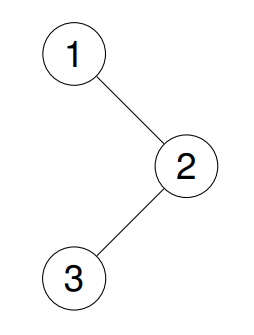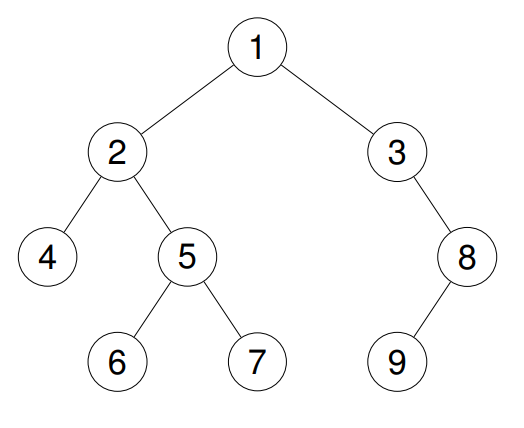145. Binary Tree Postorder Traversal
Description
Given the root of a binary tree, return the postorder traversal of its nodes’ values.
Example 1:
- Input: root = [1,null,2,3]
- Output: [3,2,1]
- Explanation:

Example 2:
- Input: root = [1,2,3,4,5,null,8,null,null,6,7,9]
- Output: [4,6,7,5,2,9,8,3,1]
- Explanation:

Example 3:
- Input: root = []
- Output: []
Example 4:
- Input: root = [1]
- Output: [1]
Constraints:
- The number of nodes in the tree is in the range [0, 100].
- -100 <= Node.val <= 100
Follow up: Recursive solution is trivial, could you do it iteratively?
Submitted Code
# Definition for a binary tree node.
# class TreeNode(object):
# def __init__(self, val=0, left=None, right=None):
# self.val = val
# self.left = left
# self.right = right
class Solution(object):
def postorderTraversal(self, root):
"""
:type root: Optional[TreeNode]
:rtype: List[int]
"""
if not root:
return []
order = []
stack = []
last_visited = None # 마지막 방문 노드(부모 노드에서 오른쪽 자식 중복 방문 방지)
next_node = root # 다음에 처리될 예정인 노드(루트에서 시작)
while next_node or stack:
if next_node:
stack.append(next_node) # 현재 위치한 노드를 스택에 추가
next_node = next_node.left # 왼쪽 자식 먼저 탐색
else:
node = stack[-1] # 현재 처리중인 노드(아직 pop하지 않음)
if node.right and last_visited != node.right:
next_node = node.right # 오른쪽 자식 탐색(아직 방문한적 없음)
else:
order.append(node.val) # 오른쪽 자식이 없거나 이미 방문했을 경우 부모 방문
last_visited = stack.pop()
return order
Runtime: 0 ms | Beats 100.00%
Memory: 12.56 MB | Beats 17.08%
후위 순회가 전위 순회나 중위 순회보다 좀 더 까다로웠다. 부모 노드로 거슬러 올라갔을 때, 이미 방문했던 오른쪽 자식을 다시 방문하는 문제를 해결하는데서 시간이 많이 들었다.
root = [1,2,3,4,5,null,8,null,null,6,7,9]
1
/ \
2 3
/ \ \
4 5 8
/ / \ /
n 6 7 9
/
n
next stack node last visit order
1 [1] None []
2 [1,2] None []
4 [1,2,4] None []
None [1,2,4] 4 4(pop) [4]
None [1,2] 2 4 [4]
5 [1,2,5] 2 4 [4]
6 [1,2,5,6] 2 4 [4]
None [1,2,5,6] 6 6(pop) [4,6]
None [1,2,5] 5 6 [4,6]
7 [1,2,5,7] 5 6 [4,6]
None [1,2,5,7] 7 7(pop) [4,6,7]
None [1,2,5] 5 7→5(pop) [4,6,7,5]
None [1,2] 2 2(pop) [4,6,7,5,2]
None [1] 1 2 [4,6,7,5,2]
3 [1,3] 1 2 [4,6,7,5,2]
None [1,3] 3 3 [4,6,7,5,2]
8 [1,3,8] 3 3 [4,6,7,5,2]
9 [1,3,8,9] 3 3 [4,6,7,5,2]
None [1,3,8,9] 9 9(pop) [4,6,7,5,2,9]
None [1,3,8] 8 9→8(pop) [4,6,7,5,2,9,8]
None [1,3] 3 8→3(pop) [4,6,7,5,2,9,8,3]
None [1] 1 3→1(pop) [4,6,7,5,2,9,8,3,1]
order = [4,6,7,5,2,9,8,3,1]
Other Solutions
1st
class Solution:
def postorderTraversal(self, root: Optional[TreeNode]) -> List[int]:
if not root:
return []
result = []
stack = [root]
while stack:
current = stack.pop()
result.append(current.val)
if current.left:
stack.append(current.left)
if current.right:
stack.append(current.right)
return result[::-1]
class Solution:
def postorderTraversal(self, root: Optional[TreeNode]) -> List[int]:
if not root:
return []
result = []
stack1 = [root] # 전위 순회(루트 → 왼쪽 → 오른쪽) 비슷하게 탐색
stack2 = [] # stack1에서 꺼낸 노드를 반대로 쌓음 (왼쪽 → 오른쪽 → 루트)
while stack1:
current = stack1.pop()
stack2.append(current)
if current.left:
stack1.append(current.left)
if current.right:
stack1.append(current.right)
while stack2:
result.append(stack2.pop().val)
return result
time complexity: 𝑂(𝑛)
space complexity: 𝑂(𝑛)
스택을 활용한 다양한 예시를 참고했다. 전위 순회 비슷하게 먼저 탐색한 뒤, 후위 순회 순서로 다시 저장하는 방법들이 많이 보였다.
2nd
class Solution:
def postorderTraversal(self, root: Optional[TreeNode]) -> List[int]:
if not root:
return []
return self.postorderTraversal(root.left) + self.postorderTraversal(root.right) + [root.val]
class Solution:
def postorderTraversal(self, root: Optional[TreeNode]) -> List[int]:
result = []
def preorder(root: Optional[TreeNode]) -> List[int]:
if root:
preorder(root.left)
preorder(root.right)
result.append(root.val)
return result
return preorder(root)
재귀 호출을 사용한 예시도 참고했다.



Leave a comment